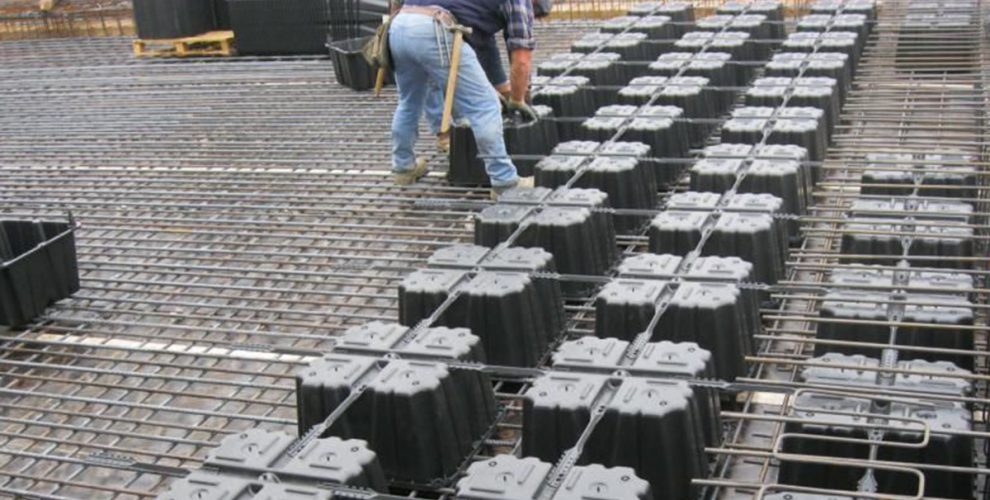U-Boot Beton is a form of recycled polypropylene that can be used to create bare slabs and rafters. It was initially applied in Italy. When laying foundations and installing slabs in areas where the ground layer capacity is very low, U-boot Beton is a simple solution to many issues. When distributing weights in deep soil, it can be used as a substitute for a raft base. In U-boot technology, however, we use U-Boot Betons to move loads to the deep ground. There are two ways to create reinforced concrete at the location using the disposable form of hollow slabs. The U-Boot Beton is used to build slabs with a wide span or that can carry heavy loads without the use of beams.
U-Boot Beton Structures:
U-Boot Beton is a reconstituted polypropylene form designed to form two-way blank slabs. It is used to construct slabs that can support heavy loads or have a wide span without the use of beams. A mixture of loose or gaseous concrete is incorporated inside another mixture to create lightweight concrete. Various building materials, including slabs and foundations, are used with the U-boot. The U-Boot Beton formwork is 52 x 52 sq. cm in size and is structured in the shape of a drunken pyramid. It is often 10, 13, 16, 20, 24, and 28 inches high.
Objects of various lengths can be loaded into sandwiches that lift two or more basic items. There are two different kinds of Betons:
- A single boot Beton is frequently used while laying reinforced slabs.
- A double U boot Beton is used when constructing double-reinforced slabs.
The single U-boot Beton is typically an open polypropylene box that can be sealed with a sealing plate to withstand the entry of concrete into the Beton. Each closed box in the Double U Boot Beton holds two.
What are the Components Of U-Boot?
The connecting bridge, spacer joint, and lock plate are the parts of the U-Boot. U-Boot Sandwich Boot Beton is made of a variety of materials. When changing the shutter, the spacer joint is used to attach two or more U-buttons so that the distance between the gaps of the U-boot Betons can be changed. The U-boot concrete box can withstand the flow of concrete inside it and is closed with the help of a lock plate.
The quality of the closing plate is crucial because it causes issues. After the concrete is installed, if the damaged plate can still be seen from the concrete, a connecting bridge must be built to extend the concrete’s length wherever it is needed. The space joint is a key aspect of U-Boot technology. U-boots built on perpendicular axes might not fit well, which could disturb the U-boots. So to prevent this, the U-boots should be joined together by a space joint.
What are the applications of U-Boot Beton?
U-Boot applications include parking lots, malls, hotels, restaurants, auditoriums, hospitals, raft foundations, mushroom pillars, temples, earthquake-resistant buildings, and fire-resistant structures.
Advantages of U-Boot Technology:
Constructing a large building using U-Boot technology, then benefits are as follows:
- The weight of the columns reduces the building’s usual load.
- Reduced foundations mean that mining can be done at a lower cost.
- Increasingly low value
- A wide range of architectural options
- Between the pillars, there are no beams.
- Reducing the number of columns will improve some of the pillars.
- Improved sound performance
- The fact that the Betons embedded in the concrete are left blank typically results in a significant reduction in the amount of concrete and metal components utilized to manufacture the slabs.
- The U-boot structure offers the same amount of capacity due to the exceptional durability of the material. As concrete and steel lose weight, a building’s overall weight typically decreases significantly. This makes it possible for owners to start a project even when the SBC for the ground is low.
- Polypropylene material, has a melting point of 230°C, making it an excellent choice for structures that must withstand both heat and fire.
What can be the economic benefits of using U-Boot Technology?
• Less concrete and connectors are used in comparison to other methods.
• Possibilities to create more parking places in order to eliminate more columns.
• There is no requirement for a fake roof, which also lessens the need for future false ceiling repairs.
Conclusion
We can definitely discuss the usefulness and benefits of the new technology given that the structural behavior of this new type of monolithic flat slab is comparable to that of a solid slab with the exception of the edge column connection. Concrete use is decreased since 100 kilograms of concrete can be replaced by 1 kg of recycled plastic. Consuming less material makes it simpler to complete projects faster, which lowers overall expenses. In addition, it has resulted in a 50% reduction in dead weight, allowing for the construction of bases that are smaller in size.
Technology is both environmentally friendly and long-lasting. Reducing the manufacturing of cement lowers worldwide CO2 emissions. The application of boot technology complements North American LEED ratings. With this new kind of hollow slab, this technology is probably used in contemporary construction and the future of public engineering.
I’m happy to share the knowledge about the benefits of U-boot technology and thanks to the college for letting me for this detailed research. We are proud to pursue in this top college in Coimbatore where we can have the opportunities to explore more in our field.
Blog by,
Anju Venugopal
Durga Priyadharshini




